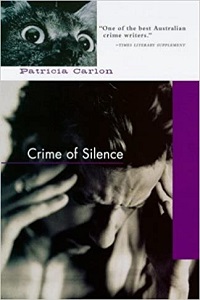
Title: Crime of Silence
Author: Patricia Carlon
Pages: 213
Published Date: 1965
Publisher: Text Australia
Series Details: stand alone
Publisher's Synopsis
A child has been kidnapped.
His father, Evan Kiley, a newspaper reporter, telephones the Wintons, a well-to-do family whose daughter had been abducted a year or so earlier. They had paid the ransom and gotten their child back without calling the police. Kiley blames this decision for his son's abduction.
Feeling guilty, Winton agrees to help Kiley. But something goes terribly wrong and a murder is committed.
Crime of Silence is a chilling psychological thriller of unnerving power and with an utterly unpredictable climax.
Review: Crime of Silence by Patricia Carlon
When small-town newspaper man Evan Kiley comes home to find that his son has been kidnapped his mind goes completely numb. He is recently separated from his wife, has succumbed to drinking rather more than he should to help ease the pain and relies on his neighbour, a spinster named Irene Suttle to come in and mind his son whenever necessary.
The telephoned warning he receives soon after he arrives home: "Don't be a fool and summon the police. We have your son." chills him to the bone. His course is set, the police must not be contacted and, as far as he is concerned, he must solve this problem alone.
But Kiley is confronted by a further problem. Sitting bound in a chair in his kitchen is the body of Irene Suttle, apparently asphyxiated by the gas coming from the stove. It appears that something was cooking on the stove when she was attacked and tied up by the intruders. When it boiled over the flame was extinguished leaving the gas to fill the house.
Now Kiley is faced with a soul-destroying dilemma. He has a dead body on his hands but he can't call the police for fear that doing so would result in the death of his son. With very few alternatives, his solution is to turn to George Winton.
Winton has already faced the nightmare confronting Kiley, his daughter having been kidnapped months earlier. The solution to his problem was to obey the kidnapper's demands to the letter, even to the extent of refusing to notify the police after his daughter's safe return. His decision to remain silent has now resulted in tremendous feeling of guilt, particularly now that it looks very much as though his silence has resulted in the same fate befalling someone else.
Winton is dragged deeper and deeper into Kiley's predicament until suddenly the entire course of events takes a dramatic turn and the stakes shift in the most unexpected of ways. The initial storyline gives way to another, much more devious scenario with more far reaching possibilities than could ever have been imagined.
Patricia Carlon was a master at constructing the most psychologically harrowing stories with deceptively simple beginnings. In this case the complexity is built piece by piece as Winton's position is made untenable until the realisation gradually dawns that his silence has placed him in a virtually impossible position.
Carlon uses an unusual, but highly effective, means of telling her story with most of the events that take place being related as recounted experiences from one character to another. In effect we are reliant on the truthfulness of each and every character for the veracity of what we are learning as the story unfolds because we never witness the events first-hand.
Another important factor towards the effectiveness of the believability of the story is the developing relationship of the characters to one another. Carlon has to sell the fact that everyone has a significant stake in the events by providing emotional motivation. By devoting a good proportion of the early part of the story to the background of her characters, she achieves this wonderfully well. Suddenly, everyone involved is bonded together towards the same goal while, at the same time, they are revealed as fully developed characters.
Although her thrillers were written over 40 years ago, Patricia Carlon's books stand the test of time maintaining a contemporary feel and dealing with relevant fears and crimes. Her prose is crisp and nicely constructed to maximise shock value while building the tension by revealing only that which is necessary to draw the reader into her web.
There is more than one way to be guilty of a crime of silence and this is never made more apparent than in this startling thriller.
